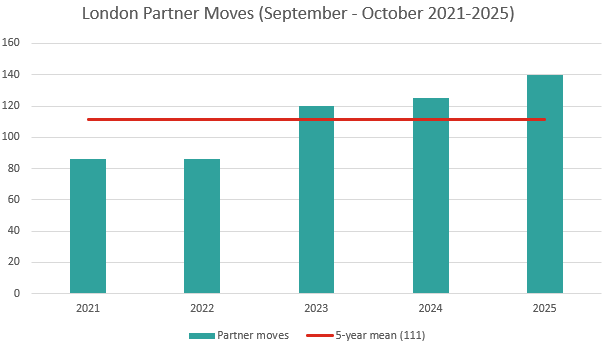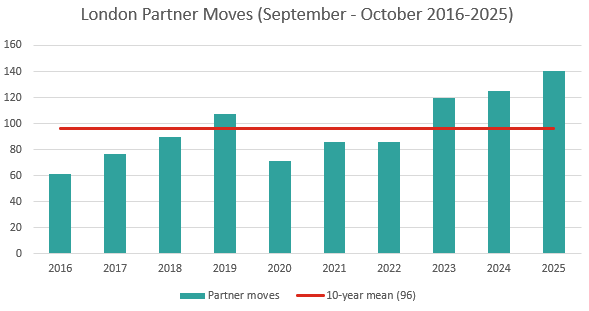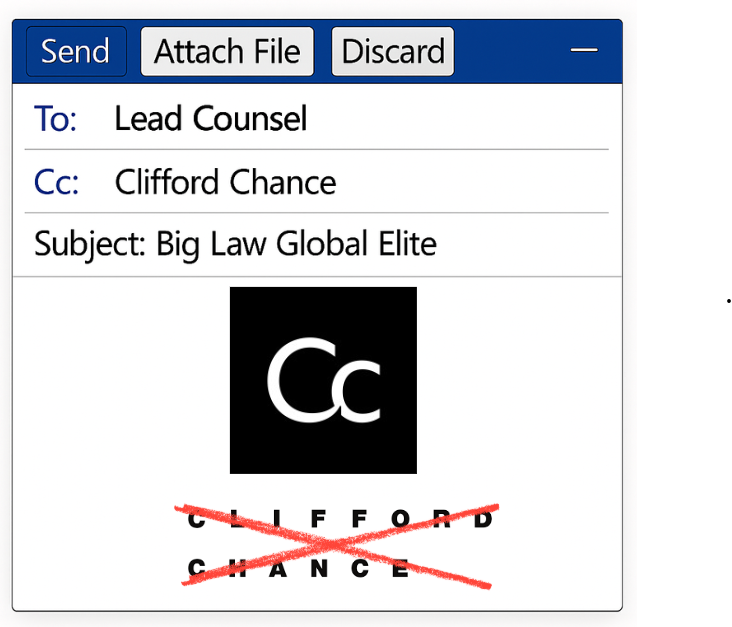Download the full Partner Moves Issue here >>
Welcome to the 89th edition of Law Firm Partner Moves in London, from the specialist partner team at Edwards Gibson, where we look back at announced partner-level recruitment activity in London over the past two months and give you a ‘who’s moved where’ update. Our records go back to 2007, and this is our methodology.
- September – October 2025
This bi-monthly round-up contains 140 partner moves, which is 12% up on the 125 we saw for the same period last year; 26% up on the cumulative five-year average (111); and 45% up on the cumulative ten-year average of (96) for the same period. The numbers continue an escalating three-year record-breaking bull run of law firm partner hires in London.


The most covetous firms this edition were Eversheds Sutherland and Orrick which hired 6 partners apiece, followed by Charles Russell Speechlys, Kirkland & Ellis, Pinsent Masons and Stephenson Harwood which hired 4. In addition, 10 firms hired three partners each: Addleshaw Goddard, Boodle Hatfield, Broadfield, Debevoise*, Gateley, Michelman & Robinson, Shoosmiths, Simmons & Simmons, Simpson Thacher and White & Case.
- Top partner recruiters in London September – October 2025
|
Eversheds Sutherland |
6 |
(2 laterals) |
|
Orrick |
6 |
(5 laterals) |
|
Charles Russell Speechlys |
4 |
(1 lateral) |
|
Kirkland & Ellis |
4 |
(0 laterals) |
|
Pinsent Masons |
4 |
(4 laterals) |
|
Stephenson Harwood |
4 |
(4 laterals) |
|
Addleshaw Goddard |
3 |
(2 laterals) |
|
Boodle Hatfield |
3 |
(2 laterals) |
|
Broadfield |
3 |
(2 laterals) |
|
Debevoise |
3* |
(3 laterals) |
|
Gateley |
3 |
(2 laterals) |
|
Michelman & Robinson |
3 |
(3 laterals) |
|
Shoosmiths |
3 |
(3 laterals) |
|
Simmons & Simmons |
3 |
(3 laterals) |
|
Simpson Thacher |
3 |
(2 laterals) |
|
White & Case |
3 |
(3 laterals) |
A total of 19 firms hired two partners each: Ashurst, Baker McKenzie, Bird & Bird, Cadwalader, CMS, Fladgate, Freeths, Hogan Lovells, Lewis Silkin, Michelmores, Milbank, Morgan Lewis, Paul Hastings, Proskauer, Reed Smith, Shakespeare Martineau, Squire Patton Boggs, Sullivan & Cromwell, and Watson Farley & Williams.
* Edwards Gibson is unable to determine if one of the laterals in a two-partner funds team arriving at Debevoise from Goodwin is joining in London or New York (see full report).
On the other side of the coin, over the same period, Paul Hastings suffered the highest attrition, losing 7 lateral partners, followed by Kirkland & Ellis (which lost 6), then Goodwin - which saw 5 partners decamp to rival firms in London (albeit two of these were from its New York office), and finally Cadwalader and Travers Smith (which lost 4 apiece).
- Firms with largest attrition in September – October 2025 (partnership to partnership moves only)
|
Paul Hastings |
7 |
|
Kirkland & Ellis |
6 |
|
Goodwin |
5** |
|
Cadwalader |
4 |
|
Travers Smith |
4 |
|
Eversheds Sutherland |
3 |
|
EY Law |
3 |
** Includes two lateral departures who moved from Goodwin ’s New York office to Debevoise in London.

- Team hires September – October 2025
The most sizeable multi-partner team move this edition was Orrick’s acquisition of a CLO and structured finance quartet from Cadwalader. The US firm also swiped an energy and infrastructure duo from fellow Los Angeles headquartered outfit Gibson Dunn.
Elsewhere, 4 firms hired two-partner teams with Debevoise snatching a private funds duo from Goodwin in New York*, and the others all departing from Paul Hastings to: Milbank (real estate finance); Hogan Lovells (corporate real estate); and White & Case (tax).
- Sullivan & Cromwell stirs
This round-up contains a cornucopia of high profile moves. Perhaps the most significant of these may prove to be Sullivan & Cromwell’s hire of Big Law heavyweights Mike Francies, the former long-term managing partner of Weil who returns to the fray after “retiring” from law last December; and restructuring specialist Kon Asimacopoulos from Kirkland & Ellis. Until this year the super elite New York firms’ London office has been (almost) hermetically sealed; since 2007 (when our records began) it hired fewer than a half-dozen partners and did not lose a single lateral to rivals in London.
This all changed in 2025 when two high profile laterals (in restructuring and leveraged finance) decamped to Gibson Dunn and the firm then hired financial services regulatory savant Barney Reynolds from A&O Shearman (legacy Shearman & Sterling). Notwithstanding the departures, it is probable that the three recent hires (in particular the arrival of Francies) are indicative of further near- term expansion by the Wall Street firm in London in its core areas of private capital, restructuring, and leveraged finance. That being said, whilst the firm maintains its all-equity partnership structure, lateral hiring will remain relatively modest and we should not expect to see anything like another Paul Weiss-style build out.
- Paul Hastings’ Partner Peril
This edition sees Paul Hastings lose 7 lateral partners in London: a two-partner corporate real estate team to Hogan Lovells; a two-partner real estate finance team (which includes the European Head of Real Estate) to Milbank; a two-partner corporate tax team (which includes the firm’s Global Second Managing Partner and Vice Chair of International Tax) to White & Case; and a further corporate real estate lateral to Cleary Gottlieb.
These moves—which leave Paul Hastings’ once-strong real estate offering with no partners in London—come on top of a slew of other significant departures in 2025. Year-to-date, the Los Angeles–spawned firm has lost a total of 16 serving partners (nearly 30% of its London line-up at the start of the year***) to rivals, including: the Co-Chair of the London office; the Global Co-Chair of Corporate; the European Head of Funds; and now the Global Second Managing Partner and Vice Chair of International Tax, as well as the European Head of Real Estate.
Against this, so far in 2025, the firm has made four partner hires in London (three laterals and one vertical) and it appears to have internally promoted three.
***According to The Lawyer, Paul Hastings had 56 partners in London in 2024.
- Taxing times for Law Firm LLPs
At the time of writing, the red-hot topic in the City is the mooted plans by the cash-strapped UK government to change the tax treatment of partnerships and, whilst there are no details as to what type of partnerships HMRC has in its cross-hairs, most commentators seem to suggest that the focus will be on Limited Liability Partnerships (LLPs). The plans, which may be announced in the 26 November 2025 budget, would likely require law firms to pay Employer National Insurance Contributions (NICs)—currently not applicable to LLPs. With the exception of Slaughter and May and Jones Day, virtually all Big Law firms in the UK are LLPs.

The broader implications and counter measures to the proposals are being extensively war gamed by law firm management and are of great concern to individual partners who stand to take a considerable financial hit if they are enacted. From a recruitment perspective there is also no doubt that the sharp reduction in law firm working capital would chill the lateral hire market.
In June Edwards Gibson published an article — Freshfields’ Non-Share Home Turf Handicap — which highlighted an obscure, but increasingly significant disparity in the existing tax legislation: the UK’s Salaried Member Rules already create a “home turf disadvantage” for UK LLPs compared to foreign LLPs, including some (albeit a minority) of US law firms. For example, as “foreign LLPs”, US LLPs are currently exempt from paying NICs on their non-share partners. We originally flagged that issue because, in light of the proliferation of two-tier partnerships among elite — and formerly all-equity — US LLPs, over the past two years the differential tax treatment of junior partners was starting to statistically impact the London hire market.
We were pleased that in October the Financial Times picked up on this issue and quoted Edwards Gibson in its article Rachel Reeves’ tax plan could benefit US law firms over UK rivals – the article highlighted that, if the new proposals are applied in the same way, the already unfair disparity between UK LLPs and US LLPs would be dramatically magnified.
- “To: CC or not CC”
Ever since the Global Financial Crisis, the private capital-powered charge on London by US law firms has left the UK’s Magic Circle looking a little less… magical in their home market. But if Clifford Chance’s new logo is anything to go by, the psychological toll might be far deeper than we thought.

Unveiled in September, the firm’s sleek new “Cc” branding is clean and modern, yet oddly familiar. We’re told that to some in-house counsel, it looks suspiciously like the email shorthand for being “cc’d.” Which, as every lawyer knows, usually means you’re looped in for visibility, not leading the charge. Indeed, some senior lawyers—but probably not too many Gen Z folks in marketing—may just about remember that “cc’d” is a quaint acronym for “carbon copied,” from the days of typewriters, when carbon paper was used to create duplicates and copies of letters were sent to additional recipients besides the primary one.
To be clear, Clifford Chance remains a legal powerhouse. Sure, like all its Magic Circle peers, it has lost ground in Europe over the past 15 years to more profitable, US-founded interlopers. Still, in a ruthlessly competitive legal services industry where every advantage counts, you have to admire those Clifford Chance rainmakers who have embraced going to market with a subliminal signal that hints at their firm’s diminished role in Big Law’s global elite. Respect!
- Other Fun Facts September – October 2025
- 34% of moves this edition were female (47).
- 9 firms hired from in-house or business: ADVANT Beiten (from Standard Chartered Bank), Charles Russell Speechlys (from Babcock International Group and Interpath Advisory), CMS (from Pod Point), DLA Piper (from Canary Wharf Group), Eversheds (from Bechtel Corporation and Pepco Group), Fenchurch Law (from Ardmore Group); McDermott Will & Schulte (from Tristan Capital Partners), Proskauer (from Oaktree Capital Management), and RPC (from CloudPay).
- 29% of all moves (40) were moves from non-partnership roles (either moves from in-house or non-partners elevated to partnership upon moving from another law firm).
CLICK HERE FOR OUR FULL September - October 2025 REPORT
Please do not hesitate to contact us if you would like to discuss this article or any other aspect of the market in more depth.
Scott Gibson, Director scott.gibson@edwardsgibson.com or +44 (0)7788 454 080
Sloane Poulton, Director sloane.poulton@edwardsgibson.com or +44 (0)7967 603 402
Please click here to understand our methodology for compiling Partner Moves
Download the full Partner Moves Issue here >>
If you would like to subscribe to our Partner Moves Newsletter, email us at support@edwardsgibson.com
 Edwards Gibson Partner Round-Up - Our Methodology
Edwards Gibson Partner Round-Up - Our Methodology Previous editions of Partner Moves in London
Previous editions of Partner Moves in London Quantifying your following and writing an effective law firm business plan
Quantifying your following and writing an effective law firm business plan Specimen partner business plan template
Specimen partner business plan template The Partnership Track and Moving for Immediate Partnership
The Partnership Track and Moving for Immediate Partnership Legal directory rankings and their effect on lawyer recruitment
Legal directory rankings and their effect on lawyer recruitment Restrictive Covenants and Moving on as a Partner
Restrictive Covenants and Moving on as a Partner
 “To: Cc or not Cc” – Clifford Chance's subversive new branding
“To: Cc or not Cc” – Clifford Chance's subversive new branding  Two Big Law Summer Weddings … and an Anniversary
Two Big Law Summer Weddings … and an Anniversary Freshfields’ Non-Share Home Turf Handicap
Freshfields’ Non-Share Home Turf Handicap Big Law Jenga: How Private Capital Stars Are Making Elite Firms Unstable
Big Law Jenga: How Private Capital Stars Are Making Elite Firms Unstable Big Law’s Brave “Few”, Their Inevitable Pyrrhic Victory, and Why This Is Still a Tragedy for The Rule of Law
Big Law’s Brave “Few”, Their Inevitable Pyrrhic Victory, and Why This Is Still a Tragedy for The Rule of Law No Accounting for the Big Four in Big Law
No Accounting for the Big Four in Big Law MIPIM 2025 Doppelgänger Style!
MIPIM 2025 Doppelgänger Style! "Memery Loss" London Law Firm Memery Crystal Sinks
"Memery Loss" London Law Firm Memery Crystal Sinks


